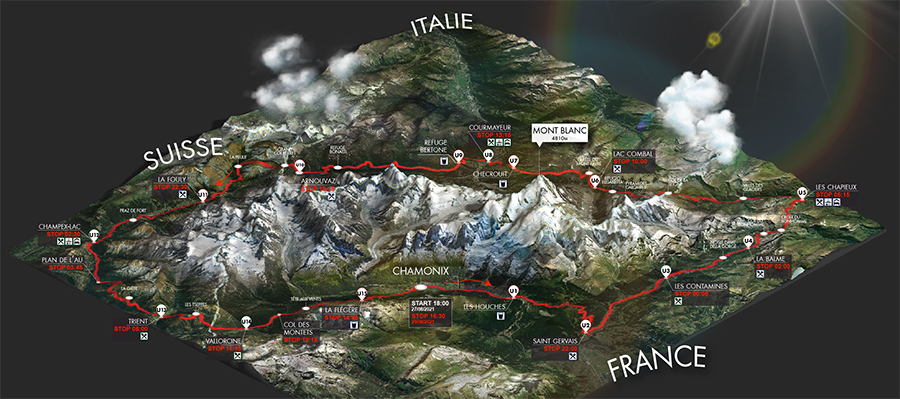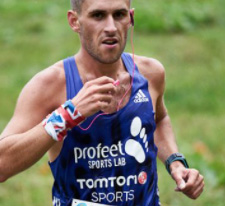Service by appointment only
Call 020 7736 0046
Call 020 7736 0046 To book

As a long-time friend and colleague of Profeet, we’re delighted to welcome Iain to our Ambassador Hall of Fame. An experienced duathlete, triathlete, ultra runner and skier, Iain regularly writes for the local and national press. He will be taking on the UTMB in August 2021 and sharing his training journey with us.
Fitness over 50
At 54 years, Iain is a veteran in the marathon and ultra running world. He’s the perfect example of how you can maintain your form across the years and continue to run at a high level. In fact, following a recent 3D Analysis and Custom Insole fitting at Profeet, he turned in an impressive time of 3:06 in the Goodwood Marathon 2021! This is not only proof positive of the benefits of Profeet’s services, but a testament to Iain’s fitness levels and commitment.

Taking on the Ultra-Trail du Mont-Blanc (UTMB)
The UTMB is a single-stage mountain ultramarathon, that follows the route of the Tour du Mont Blanc through France, Italy and Switzerland. It has a distance of approximately 171 kilometres (106 miles), and a total elevation gain of around 10,040 metres (32,940 ft). Not surprisingly, it is widely regarded as one of the most difficult foot races in the world – most runners take 32 to 46 hours to reach the finish line and have to run through two nights in order to complete the race. We feel tired just thinking about it!

Words of wisdom from Robbie Britton
Whilst Iain is immersing himself in training we took the opportunity to ask another Profeet Ambassador, former Team GB ultra runner Robbie Britton, who has already faced down the UTMB, for advice. Here’s the conversation… it’s an education.
Q: Iain Martin
Although I hope to get to the Alps as part of my preparations (travel bans notwithstanding) most of my training will be here in the UK. How can I best prepare for alpine running when my nearest peak is only 240m?
A: Robbie Britton
Great question. Plenty of people have successfully trained for mountainous races in flatter countries and 240m is pretty handy actually. People think the uphills are the main issue at UTMB but it will be the long descents that will be the undoing of many an unprepared runner.
Think about conditioning your legs for the descents, but also working on being as efficient as you can downhill, which might be more down to technique. Every hill you run down, from now until UTMB, is a chance to think about your technique and often getting people to slow down a little is the first step. The biggest damage comes from having to slam on the brakes too often, so if you go a little bit slower, don’t have to brake as often and can manage the obstacles in front of you by jumping from side to side, then you will find you actually get down the hill quicker, but also in better shape.
Another great session for downhill conditioning is continuous hills, which you only really need 45-60 seconds of runnable up and downhill to work with. Then it’s a controlled effort, for example, 3 x 8-10 minutes, where you go up AND DOWN the hill at the same effort level. Not the same pace, as you’ll be slower going up, but maintain the same effort for the entire 8-10 minutes, then rest for 2-3 minutes and go again. This can be quite a hard session the first couple of times, so allow decent recovery between and don’t progress too quickly. Pick a gradient and terrain that you are comfortable running down at effort as if you have to slow down because it’s too steep or too technical then you’re losing a bit of the purpose of the session.
If you can, government guidance allowing, get to some of the beautiful bigger hills in the UK – they can be great training. The Brecon Beacons, Snowdonia, the Peak and Lake District or the wilds of bonnie Scotland all have great mountains to enjoy. Think of these as bigger days out on feet and rather than running everything, do as you would on race day and practice hiking, using poles, fuelling and enjoying the descents.
Q: Iain Martin
Should I be upgrading my kit to lighter options to keep my backpack weight down?
A: Robbie Britton
The weather on race day and how long you intend to be out, (most people are out for two nights and then some of the following days too), will heavily influence the kit choices for the race. Yes, some of the elites are taking tiny phones and super lightweight kit, but if a storm comes in then everyone with half a brain is swapping that crisp packet waterproof for a decent three-layer Gore-tex number.
So my advice is to look for the best kit for the conditions, which might be a lightweight kit for some items, but might also be a kit that saves your race, or your life, in a storm on the second night. The kit you don’t want to try to save weight on includes head-torches (it doesn’t matter how light your kit is if you can’t see where you’re going) and gloves (because with cold hands you can’t do anything).
Utilise the drop bag system and maybe have spare clothing for the second night or an extra jumper if you know you get cold in the latter stages of races when low on energy and moving a little slower.
Q: Iain Martin
Do I need a support crew, and if so, what advice do you have for them?
A: Robbie Britton
You don’t need a support crew, but they are nice to have. For some, it adds extra pressure to race well, which can be good or bad. You can see your crew at Les Contamines, Courmayeur and then three more key points before the finish (they get closer together as the runners get slower). Some will linger more in a checkpoint with their crew so have a plan beforehand and let them know you’re very grateful before the race, as you might act like a spoilt child during it.
Q: Iain Martin
Age-group athletes like me will have to go through two nights on the trail – do you recommend taking short naps, or should you try and push through?
A: Robbie Britton
The two-night issue is a difficult one and comes down to how well your sleep has been in the build-up, how well you fuel and pace, what the weather is like and a lot of other factors. I’ve cycled through two nights before and tactical use of caffeine, but also managing effort and fuelling well all help.
Ultimately it’s a build-up of adenosine in the brain that will make you super sleepy and the only way to dissipate that is through a wee sleep. If you find yourself falling asleep on your feet then a 15-20 min power nap might bring a new you. Take a coffee before you nap and hopefully, that kicks in as you wake up too and if you need to do the same again in a couple of hours then it can be more efficient. Get through to sunrise and you’ll feel fresh as a daisy…well better than the sack of sh** you felt like the night before.
Q: Iain Martin
Nutrition is literally each to their own taste but is there anything, in particular, I should be aware of?
A: Robbie Britton
You need carbs. Think about how many grams of carbs you are getting per hour, keep it consistent throughout and put the same effort into eating as you do into pushing your legs in the final stages. The harder you work at your fuelling the less you have to work on everything else.
Q: Iain Martin
What single piece of advice would you offer to a first-timer for the UTMB?
A: Robbie Britton
Enjoy it. Don’t get carried away on the river trail to Les Houches and if you eat and pace well you will pass a lot of people in the second half, especially in the checkpoints. Also, don’t destroy your race by doing 104 laps of the race expo and six vertical kilometres in the week before the race.
Q: Iain Martin
What are the greatest challenges – pacing yourself, lack of sleep, altitude etc…
A: Robbie Britton
Not getting carried away at the start and sprinting through Chamonix. Relax, breath in the atmosphere and save that sprint for the final push through town. Altitude will make everything feel tougher, but just remind yourself it’s the altitude and it’s the same for everyone.
Some great advice there from Robbie, thank you!
Robbie Britton – Ultra Runner
You might also like to read this article from 2015 when we talked to Robbie Britton about training for the UTMB in Chamonix.
Follow Iain’s path to the UTMB
We’ll be following Iain as he works his way through a demanding training plan in the run-up to this awe-inspiring event. We’ll share the highs, the lows, the peaks, the ditches, and the rabbit holes, so you can get a taste of the ‘ultra life’. Given that many of us regard a marathon as a life challenge and peak achievement, the ultra is a fascinating, fearsome beast of a thing – on a whole other level.
Sign up to our monthly community newsletter (for updates, tips, stories, sale previews and VIP offers) and get the latest delivered to your inbox.
OUR SERVICE IS BY APPOINTMENT ONLY
Profeet’s services are by appointment only, please call or book online in advance

